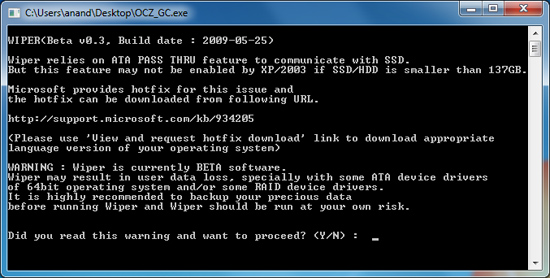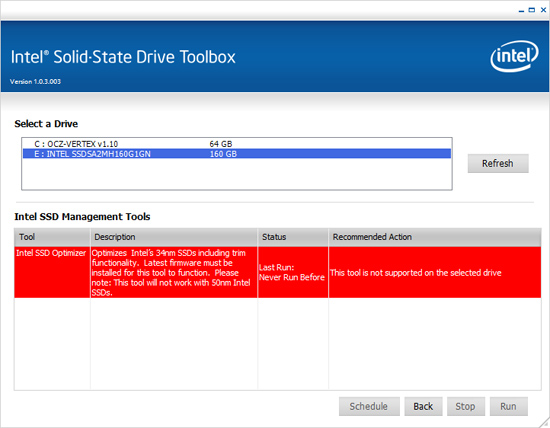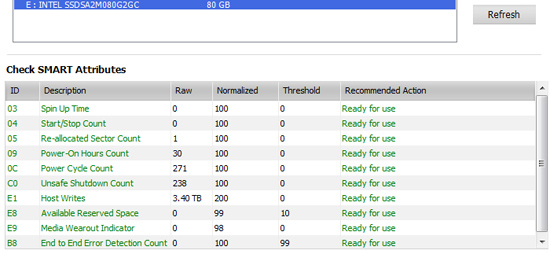The SSD Improv: Intel & Indilinx get TRIM, Kingston Brings Intel Down to $115
by Anand Lal Shimpi on November 17, 2009 7:00 PM EST- Posted in
- Storage
Wipe When You Can’t TRIM
There’s a major problem with TRIM today. The only Windows storage drivers to support it are written by Microsoft. The Intel Matrix Storage Manager (IMSM) driver will not pass the TRIM instruction to your SSD. This means you can't use anything but the drivers that ship with Windows 7. To make matters worse, if you enable non-member RAID on an Intel motherboard the default Windows 7 driver is an older version of IMSM so TRIM won't work there either - even if you don't have a RAID array created. Your best bet is to install Windows 7 with your I/O controller in AHCI mode (for Intel chipsets) and don't install any storage drivers. Intel is working on an updated IMSM that will pass the TRIM instruction to SSDs but it won't be ready for at least a couple of months.
TRIM won't work on a RAID array.
If you want to use IMSM or if you're using Windows XP or Vista, both of which do not support TRIM, there's another option. Earlier this year Indilinx released its Wiper Tool that performs a manual TRIM on their SSDs. It works by asking the OS for a list of the free space addresses on the partition and then sending the list with instructions to TRIM down to the SSD.

The Indilinx Wiper Tool
Today Intel introduces its own manual TRIM tool as a part of the SSD Toolbox:

On any Windows OS (XP, Vista or 7) regardless of what driver you have installed, Intel's SSD Toolbox will allow you to manually TRIM your drive. Intel calls it the SSD Optimizer, which of course only works on 34nm Intel SSDs (X25-M G1 owners are out of luck unfortunately).

The Intel SSD Optimizer lets you schedule the manual TRIM operation automatically
The SSD Toolbox also gives you access to SMART and drive health data, including telling you how many writes you've performed on your SSD, and what your current flash wear level is:

Running Intel's SSD Optimizer does work as advertised. I ran the PCMark HDD suite on a clean X25-M, once more on a drive that had been well used and once more after running the SSD Optimizer:
| PCMark Vantage HDD Score | Clean Run | Used Run | After SSD Optimizer |
| Intel X25-M G2 160GB | 35909 | 30354 | 34014 |
Intel's SSD Optimizer should be able to restore performance to about 95%+ of new, in this case it manages 94.7% - close enough.
Moving On: Forget About Invalid Data and Worry About Free Space
The existence of TRIM changes the way we test, something I alluded to in the SSD Relapse. Thankfully, we come prepared.
In previous articles we had to test SSDs in two conditions: new and used. The new state is just after a secure erase, the used state required us to write data to every user accessible portion of the drive first before benchmarking. The former resulted in great performance, the latter meant the SSD had to do a lot of juggling of existing data whenever it went to write. The second scenario no longer exists with TRIM. The act of formatting your drive or deleting files (and emptying the recycle bin) will TRIM invalid data.
Performance in a TRIM enabled system is now determined not by the number of invalid blocks on your SSD, but rather the amount of free space you have. I went into a deep explanation of the relationship between free space and the performance of some SSDs here.
TRIM will make sure that you don’t have to worry about your drive filling up with invalid data, but it doesn’t skirt the bigger issue: dynamic controllers see their performance improve with more free space.
My rule of thumb is to keep at least 20% free space on your drive, you can get by with less but performance tends to suffer. It doesn’t degrade by the same amount for all drives either. Some controllers are more opportunistic with free space (e.g. Intel), while others don’t seem to rely as much on free space for improved performance. Addressing performance degradation as drives fill up (with valid data) will be one of the next major advancements in SSD technology.










162 Comments
View All Comments
EasterEEL - Monday, October 26, 2009 - link
Once the Intel firmware is updated to v1.4 with trim support does Windows 7 start using trim? i.e I have already installed Windows 7 before dong the firmware update.Does ghosting an image back to the SSD have any impact on trim??
magreen - Monday, October 26, 2009 - link
That Kingston for $85 is looking tempting for sprucing up a circa-2004 laptop of mine that I use daily. But the laptop is ide. I know of others in the same boat.Have you heard of anyone producing an inexpensive quality ssd for ide? The Kingston seems like the perfect candidate since it's anyways not as fast as the regular Intels.
Zoomer - Monday, October 26, 2009 - link
Make sure that the drive interfaces match. If it's from 2004, it might still be PATA. I'd imagine this is SATA only.That said, it'll be interesting to see if soldering more flash chips on = upgrade in space. Shouldn't be too hard to find the flash chips (2 * Kingstons < Intel), but I'll need to find a good soldering jock.
magreen - Thursday, October 29, 2009 - link
Ummmm... maybe I wasn't making myself clear.I wasn't referring to upgrading the drive's capacity.
I was referring to Kingston producing a PATA drive that would work with my PATA laptop. I know PATA doesn't work with SATA. (I loosely referred to PATA as IDE, which people often do...)
thanx
IMFTbestFab - Monday, October 26, 2009 - link
You can't upgrade capacity like this. The drive has a maximum LBA associated with it, presumably set at the factory.Eeqmcsq - Monday, October 26, 2009 - link
Another great SSD article, Anand. Found a problem: Page 3, "Wipe When You Can’t TRIM", when you said "I went into a deep explanation of the relationship between free space and the performance of some SSDs here.", it sounds like there should be a link to a previously written article, but there is no link.ekbond - Monday, October 26, 2009 - link
Any thoughts on TRIM support in OS X?The download page for Intel's SSD utility specifies that it's OS independent, while the user guide says Windows is required.
Apart from formatting the drive, are there any other ways to restore performance (via TRIM or otherwise) currently available to OS X users?
Anand Lal Shimpi - Monday, October 26, 2009 - link
OS X doesn't have TRIM support yet unfortunately. I'm trying to get Apple to at least acknowledge that they will be supporting the feature but haven't had any luck yet. I haven't tried some of the erase options in Disk Utility to see if they do the equivalent of a secure erase. I'll try barking up that tree shortly.Take care,
Anand
chizow - Monday, October 26, 2009 - link
Newegg will just gouge the crap out of prices regardless. $100-130 will be more like $150-180. Remember when you said Intel would be dropping SSD prices with the G2 to $230 and $450 for the 80g and 160g respectively?http://www.newegg.com/Product/ProductList.aspx?Sub...">http://www.newegg.com/Product/ProductLi...scriptio...
They were sub $250 for about 12 hours total since Newegg got them in stock 2 months ago after the initial "recall".
strikeback03 - Tuesday, October 27, 2009 - link
I picked up my 80GB G2 a couple weeks ago from Newegg for $239 shipped, for the retail boxed one; the deal also included a Icy Dock 2.5" to 3.5" adapter and a ThermalTake Element S case for $30 with a $30 MIR.